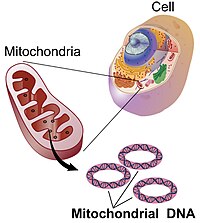
Photo from wikipedia
A retrospective case control study was undertaken at the molecular biology department of a private center for reproductive medicine in order to determine whether any correlation exists between the mitochondrial… Click to show full abstract
A retrospective case control study was undertaken at the molecular biology department of a private center for reproductive medicine in order to determine whether any correlation exists between the mitochondrial DNA (mtDNA) content of trophectoderm and embryo developmental potential. A total of 275 couples underwent IVF treatment, producing a total of 716 embryos. The trophectoderm was biopsied from each embryo at the blastocyst stage (day 5 or day 6 post-fertilization) subjected to low-pass next-generation sequencing (NGS), for the purpose of detecting aneuploidy. For each sample, the number of mtDNA reads obtained after analysis using NGS was divided by the number of reads attributable to the nuclear genome. The mtDNA copy number was found to be higher in aneuploid embryos than in those that were euploid (mean mtDNA ratio ± SD: 1.13 ± 1.37 versus 1.45 ± 1.78, p = 0.02) and in day 5 biopsies compared to day 6 biopsies (1.41 ± 1.66 vs. 1.19 ± 1.27, p = 0.001), whereas no statistically significant differences in mtDNA content were seen in relation to embryo morphology (1.58 ± 2.44 vs. 2.19 ± 2.89, p = 0.12), genetic sex (1.27 ± 1.29 vs. 1.27 ± 1.18, p = 0.99), maternal age (1.31 ± 1.41 vs. 1.33 ± 1.29, p = 0.43), or its ability to implant (1.14 ± 0.88 vs. 1.21 ± 1.16, p = 0.39). mtDNA has small potential to serve as an additional, independent biomarker for embryo selection.
Journal Title: International Journal of Molecular Sciences
Year Published: 2022
Link to full text (if available)
Share on Social Media: Sign Up to like & get
recommendations!